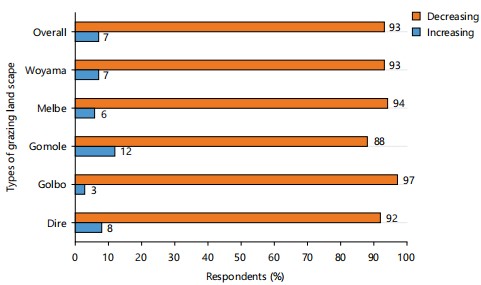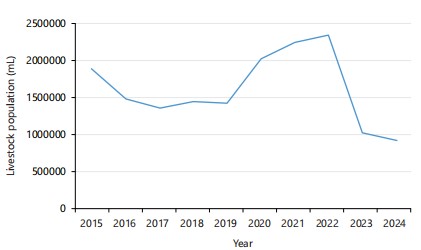Status of Borana Cattle Breed in Borana Zone of Oromia Regional State, Ethiopia
| Received 18 Mar, 2025 |
Accepted 28 Jun, 2025 |
Published 30 Sep, 2025 |
Background and Objective: One of the native cattle breeds from the Southern Ethiopian Borana rangelands is the Borana cattle breed, known as Bos indicus (humped Large East African Shorthorn Zebu type). The study’s objective was to assess the current status of the Borana cattle breed and identify the main factors contributing to genetic erosion in the study areas. Materials and Methods: The study was conducted in five grazing land escapes (Dire, Golbo, Gomole, and Woyama) in the Borana, Oromia Regional State, Ethiopia, from September, 2021 to June, 2023. Multistage sampling techniques were employed to gather data. Data were collected through semi-structured questionnaires, focus group discussions, field observations, and census data. About 360 smallholder pastoralists were interviewed. Both SPSS statistical software and indices were used to analyze survey data and ranking data, respectively. Results: Respondents and focus group discussion confirmed the presence of two distinct sub-types of the Ethiopian Boran cattle, Qorti and Ayuna. Qorti is preferred to Ayuna by the community due to their superiority in terms of production and reproduction performance, as well as higher prices at the market when sold. Respondents, focus group discussion, and key informants with secondary data also explained that the population of Borana cattle (Qorti) strains is a decreasing trend, while Ayuna showed a reverse. The main factors for the decreasing trend were drought and shortage of feed during the dry season, followed by high blood mixture with local inferior neighbour cattle, disease, and shortage of grazing land due to Bush and crop farms encroaching on the study areas. Despite these special qualities, the breed is under threat. Conclusion: An integrated community-based participatory in situ conservation program with the open-nucleus breeding strategy of the Boran breed is promised but would require the collaboration of all stakeholders at all levels and a deeper understanding of the potential of this exceptional animal.
| Copyright © 2025 Hussien et al. This is an open-access article distributed under the Creative Commons Attribution License, which permits unrestricted use, distribution, and reproduction in any medium, provided the original work is properly cited. |
INTRODUCTION
Due to its diverse agro-ecology and proximity to the center of livestock domestication, Ethiopia is endowed with a wealth of genetic resources for livestock1. The Borana cattle breed, also known as Bos indicus (humped Large East African Shorthorn Zebu type), is a native breed of cattle from the Southern Ethiopian Borana rangelands. The Oromoo pastoralists raise these cattle for their meat and milk. They are originally from Ethiopia and were first introduced to Kenya by Southern Ethiopian pastoralists known as the Borana2. Numerous adaptive mechanisms are present in animals, which aid in their ability to survive in hostile environments. Vast arrays of physiological processes, as well as behavioral and morphological traits, are examples of adaptations to warm climates. One of Borana cattle’s special advantages is their capacity to withstand high ambient temperatures, seasonal fluctuations in feed supply and quality, water scarcity, and high disease incidence, including tick infestations2. During times of feed scarcity and lactation, the cows ability to convert pasture forage into body fat deposits is highly efficient. Therefore, the cows rarely lose body condition as a result of breastfeeding or mild droughts3. Nonetheless, the Borana lowlands livestock productivity is facing significant obstacles due to dwindling feed quality and availability brought on by growing population pressure, land use change, rangeland degradation, bush encroachment, and climate change. The Ethiopian Boran cattle breed is also under threat from a number of other factors, such as dilution with other breeds, a lack of systematic breeding and selection programs, and frequent drought4. There is a dearth of thorough information regarding the adaptation, reproduction, and productivity of the Boran cattle breed in the lowlands of the Borana rangelands. Additionally, the Borana breed is at risk of genetic erosion due to the admixture of other breeds used for drought-restocking5. This study aimed to explore the current status of the Borana cattle breed in Southern Oromia, threats that contributed to genetic erosion, and to inform communities about the sustainable management and conservation strategies with the following objectives. To assess the current status of the Borana cattle breed in the study areas and to identify the main factors that are contributing to the decline Borana cattle population.
MATERIALS AND METHODS
Description of the study area: The study was conducted in five grazing land escapes (Dire, Golbo, Gomole, and Woyama) in the Borana, Oromia Regional State, Ethiopia, from September, 2021 to June, 2023. The Borana Zone lies between Latitudes 3°26' and 6°32'N and Longitudes 36°43' and 40°46'E in the Southern part of Oromia Regional State. The Borana Plateau is the portion of the Southern Ethiopia rangelands whose climate is generally semi-arid with an annual rainfall range of 500 mm in the South and 700 mm in the North, the altitude ranges from 1000 m in the South to 1500 m in the Northwest, and the rainfall is bimodal but erratic in distribution. Fifty-nine percent (59%) of annual precipitation occurs from March to May, and 27% from September to November; the annual mean daily temperature varies from 19 to 24°C. The Borana Plateau has been divided into four main seasons. One of these is the long rainy season (Ganna, March-May); the cool dry season (Adoolessa, June-August); the short rainy season (Hagayya, September-November); and the warm dry season (Bona, December-February)6.
Based on the features of the natural resources, Borana pastoralists divided the Borana rangelands into two zones, Liban and Dirre, each with its own grazing system. Liban stood for the region north of the Dawa River, which was historically significant because it could accommodate the ceremonial rites of the Borana pastoralists. In Liban, herd movements were limited to grazing along the river at Golbo Liban during the dry season, and grazing was moved to Diid Liban to the east during the rainy season. The term “Dire” describes the whole region south of the Dawa River. Here, the pastoralists used the standard Borana rotational grazing system in the vicinity of the pastures, permanent water sources, and salt. The center of Dirre is home to the traditional well complexes (Tula), which are surrounded by white soil valleys. During dry seasons, many herds of cattle from all directions were drawn to these areas by their permanent water supplies. Smaller, shallower wells (Adadi) were used close to the edge of these rangelands to help reduce the animals momentary elevated pressure. Wet-season grazing areas, which were accessible throughout the year, encircled these dry-season areas. Wayama, the plain grasslands to the east, were reportedly very valuable for cattle. High-quality natural pasture was abundant in these regions due to their fertile soils and broad, level terrain. The northern Gomoole regions were also advantageous for cattle. Because the Golboo and the Southern regions of Malbee were better suited for small ruminants, fewer herds were moved there. These areas also attracted herds from the foothills of the neighboring mountain ranges7.
Site selection and sampling techniques: Before selecting the study areas, discussions were held with the zonal and district experts of the Agricultural and Natural Resource Offices about the local cattle of the area. After a series of discussions, a multistage sampling technique was employed in gathering information on the purpose of keeping cattle, population and dilution trends, reproduction and production performance, husbandry practices, major constraints, and physical descriptions of cattle in the study area. The first stage involved selecting all five types of grazing land escapes from the Borana zone. In the second stage, from each grazing land escape two districts were selected from each of the five grazing types purposively, based on the cattle population and security problem-free districts. Accordingly, two PAs were selected from each district randomly. In the third stage, each of the PA’s eighteen cattle owner households was selected systematically. This led to the selection of 360 households based on cattle ownership and on identified ethnic groups. Finally, semi-structured questionnaires were administered to capture data.
Exploratory study: This was done to have an overview of the study components and to pre-test the designed questionnaire. The participants of the exploratory study were focus groups of key informants, elders, Zonal and Districts’ Bureau of Agricultural and Natural Resources, Animal Production and Breeding Officers, and community leaders who are directly and indirectly involved in Indigenous cattle production and utilization.
Questionnaire design and data collection: Both qualitative and quantitative data were collected from secondary and primary sources from the selected districts and communities. Home-to-home interviews were done by researchers with the help of DAs of each peasant association. Semi-structured questionnaires were prepared for respondents accordingly. The questionnaires were initially prepared in English and later translated into Afan Oromo (local language), and then a pre-test of the interviews was carried out before the actual interviews were started. The primary data were collected from the target respondents. The secondary data were collected from the zonal and district agricultural offices and other relevant sources.
Focus group discussions: Focus group discussions were held with community elders of both sexes, zonal and district level experts, development agents, PA leader researchers, and elders who are known to have better knowledge of the present and past livestock production trends and social and economic status of the area. A total of 5 group discussions, the grazing landscape comprising twelve to fifteen members, was organized. Before the discussion, participants of each group were briefed about the objective of the study.
Statistical analysis: The SPSS statistical software (SPSS for Windows, release 20.0, 2011) was used to analyze survey data. Indices were calculated for all ranking data using the formula:
Given for an individual reason/criteria divided by:
For overall reasons/criteria.
RESULTS AND DISCUSSION
Current status and threats of the Borana cattle breed
Origin and distribution of the breed: In terms of geographical distribution, the Ethiopian Borana cattle have a significant presence in the landscapes of Kenya and Ethiopia. Their ancestral roots can be traced back to Ethiopia, and their initial introduction into Kenya occurred through pastoral movements initiated
by Oromo tribes migrating from Southern Ethiopia. Distinct variations within the Borana breed have emerged, with three recognized types: The Orma Borana, the smallest of the three, dwelling in Ethiopia; and the unimproved Borana and improved Borana, primarily found in Kenya which agrees with finding of Oncho et al.8. The breed originated in the semi-arid pastoral Borana Plateau of Southern Ethiopia is thus strongly supported by focus group discussions and respondents.
Local naming of Borana cattle: Respondents and focus group discussions revealed the existence of two unique sub-types of Ethiopian Boran cattle. Borana pastoralists favor the large-framed Qorti breed, regarded as the authentic kind of Ethiopian Borana cattle. In contrast, the Ayuna type was described as shorter in height and smaller in body size, but more amenable to adapting to degraded rangeland conditions than the Qorti sub-type. The finding also coincides with Mekuriaw and Kebede9 ,wich states that, the production and reproduction traits of Borana cattle, including the differentiation between the two sub-types and their varying levels of adaptability to different environmental conditions. The idea from the focus group discussion also explained that the most common criteria to distinguish Ayuna from the Qorti sub-type are their smaller body size and conformation, while color is the least common criterion for distinguishing Ayuna from the Qorti sub-type, except black, which is mostly associated with finding finding of Haile et al.10. Qorti is preferable to Ayuna by the community due to their superiority in terms of production and reproduction performance, as well as higher prices at the market when sold (Table 1). The community chooses Ayuna over the Qort sub-type only due to its stronger resilience to drought and hard circumstances, which adapt poorly to the paucity of forage supplies. This finding agreed with the finding of Homann11, which stated that Qorti was observed to show lower tolerance to drought and tick burden and poor adaptation to scarcity of pasture compared to Ayuna.
Population trend of Borana cattle (Qorti): According to key informants, focus group discussions, and the overall percentage of respondents (93%) (Fig. 1), the population of Borana cattle (Qorti) strains is declining while Ayuna is reversing. Gomole grazing land escapes had the lowest declining trend (88%), while the Golbo had the highest (97%) declining trend, according to respondents (Fig. 1). Because the Gomole is close to the Did-Xuyura ranch, Yabello Pastoral, and Dryland Research Center, it may be easier to find breeding Qorti bulls there, which could explain this discrepancy. Key informants, focus groups, and respondents also indicated that the primary causes of the declining trend were drought and feed scarcity during the dry season, followed by disease, a high blood mixture with inferior neighbor cattle from the area, and a lack of grazing land as a result of crop farm and bush encroachment in the study areas. This occurred as a result of Qorti sub-type’s lower ability to withstand harsh environments than Ayuna, which raises the likelihood that Ayuna will eventually be replaced. This finding was in line with the finding of Gebissa12, which claimed that the drop in Qorti’s trend was caused by their inability to adapt to the wildly changing weather.
| Table 1: | Local naming of Borana cattle, community preferences and reasons for preference | |||
| Variables | Dire (n = 65) |
Golbo (n = 22) |
Gomole (n = 90) |
Melbe (n = 78) |
Woyama (n = 105) |
Overall (n = 360) (%) |
| Local name of cattle | ||||||
| Qorti and Ayuna | 100 | 99 | 100 | 100 | 100 | 99.8 |
| Preference from the two strains | ||||||
| Qorti | 94.44 | 100 | 95.83 | 91.67 | 97.22 | 95.20 |
| Gelaba | 5.56 | 0 | 4.2 | 8.33 | 2.78 | 5.80 |
| Reason for preference Qorti | ||||||
| Have a higher milk yield | 97 | 98.5 | 99.5 | 99 | 100 | 99.01 |
| Have higher price | 98 | 98 | 99 | 98.5 | 98.8 | 98.76 |
| Have a higher meat quantity | 99 | 99.5 | 98.65 | 98 | 99.4 | 99 |
| Can deliver bigger calves | 96 | 98 | 99 | 95 | 97 | 97 |
| Reason for preference gelaba | ||||||
| Can tolerance of harsh condition | 99 | 100 | 99 | 99 | 98 | 99 |

|

|
Secondary data from the Zonal agricultural office shows the population size in general (Qorti and Ayuna) for one decade (Fig. 2).
The line graph showed that the population of cattle fluctuated (down and up trend) (Fig. 2). The number of cattle rapidly decreased from 1, 881, 212 in 2015 to 1, 358 ,121 in 2017 when there was drought, then increased slightly from 1, 358, 121 to 1, 442, 920 in 2018 and again fell very slightly to 1, 416, 180 in 2019. The cattle population suddenly increased to 2, 338, 998 from 2019 to 2022 and then sharply fell to 921, 551 from 2022 to 2023/2024, which was due to a serious drought. Overall, the cattle population increased during the wet season when there was enough rainfall, while it decreased when there was drought or a shortage of rainfall.
Constraints that lead to the decline Borana cattle (Qorti) population in the study area: The major factors that contributed to the decline of the Borana cattle population were summarized in Table 2. Focus group discussion with multiple-response analysis indicated that overall, factors that contributed to the decline in productivity constraints of the Borana cattle population.
A high blood mixture with local inferior neighbor cattle with an index of 0.41 and 0.20, respectively, was caused by drought and feed shortages during the dry season. With indices of 0.15, 0.13, and 0.11, respectively, disease, a lack of breeding bulls, and a lack of grazing land as a result of bush and crop farm encroachment were additional factors that contributed to the decline and genetic erosion of the Borana cattle population. This finding is partially agreed with the finding of Bayssa et al.13. The next factor was a high blood mixture with inferior neighbor cattle from the area. This occurred because the Qorti sub-type is less tolerant of harsh conditions than Ayuna, which raises the likelihood that Ayuna will be replaced. This finding was in line with the finding of Gebissa12, which stated that the trend for Qorti was decreasing due to less coping of Qorti to the dramatically fluctuating climatic conditions.
| Table 2: | Major factors that contributed to the decline of the Borana breed of cattle in the study area | |||
| Grazing landscape | Major constraints | 1st rank | 2nd rank | 3rd rank | Index |
| Dire | Drought+feed shortage | 55 | 13 | 4 | 0.45 |
| Shortage of grazing land | 1 | 5 | 10 | 0.05 | |
| Shortage of breeding bull | 2 | 9 | 16 | 0.1 | |
| Disease | 3 | 23 | 16 | 0.16 | |
| Blood mixture with local cattle | 11 | 22 | 26 | 0.24 | |
| Golbo | Drought+feed shortage | 40 | 20 | 12 | 0.4 |
| Shortage of grazing land | 4 | 10 | 14 | 0.11 | |
| Shortage of breeding bull | 10 | 12 | 12 | 0.15 | |
| Disease | 8 | 12 | 16 | 0.15 | |
| Blood mixture with local cattle | 10 | 18 | 16 | 0.19 | |
| Gomole | Drought+feed shortage | 41 | 19 | 12 | 0.4 |
| Shortage of grazing land | 3 | 4 | 3 | 0.09 | |
| shortage of breeding bull | 5 | 6 | 14 | 0.04 | |
| Disease | 9 | 18 | 23 | 0.2 | |
| Blood mixture with local cattle | 14 | 25 | 21 | 0.26 | |
| Malbe | Drought+feed shortage | 37 | 23 | 12 | 0.39 |
| Shortage of grazing land | 2 | 3 | 4 | 0.04 | |
| shortage of breeding bull | 5 | 5 | 6 | 0.09 | |
| Disease | 20 | 27 | 30 | 0.25 | |
| Blood mixture with local cattle | 8 | 14 | 20 | 0.23 | |
| Woyama | Drought+feed shortage | 50 | 13 | 9 | 0.43 |
| Shortage of grazing land | 4 | 7 | 4 | 0.04 | |
| shortage of breeding bull | 6 | 35 | 23 | 0.16 | |
| Disease | 6 | 8 | 7 | 0.11 | |
| Blood mixture with local cattle | 6 | 10 | 19 | 0.26 | |
| Overall | Drought+feed shortage | 223 | 88 | 49 | 0.41 |
| Shortage of grazing land | 23 | 48 | 51 | 0.11 | |
| Shortage of breeding bull | 27 | 48 | 73 | 0.13 | |
| Disease | 29 | 81 | 75 | 0.15 | |
| Blood mixture with local cattle | 53 | 84 | 96 | 0.2 | |
| Ranks were based on the number of responder | |||||
Measures taken by different stakeholders to maintain the Borana cattle breed in the study areas
Pastoral community: According to the Focus group discussion with key informants, the majority of pastoralists were informed about the merits of Borana Breed cattle (Qorti sub-type), especially by their higher production and reproduction performance over the Ayuna. Accordingly, they managed their animals by separating calves, weak animals, lactating cows, and breeding bulls to Kalo as well as supplementing different tree branches, acacia pods, wheat bran, and a little salt, especially during the dry season, in addition to their migration habit. To buy concentrated feed for their animals, they sold other animals, especially small ruminants. One significant practice I saw in focus group discussions with pastoral communities was the killing of calves born during droughts to save their dam, in addition to providing traditional and contemporary medical care for their animals.
Government institution
Dida xuyura ranch: The only large ranch left dedicated to the genetic improvement of Boran cattle is Dida Tiyura Ranch, which has spent the last 20 years working to improve, multiply, and distribute bulls for the communities. As part of the dissemination strategy, a bull is sold to specific pastoralists on an
individual basis. The dissemination strategy is in such a way that a bull is sold to selected pastoralists and other bodies at a lower price than the market. Despite being the primary center for the conservation and enhancement of the Borana cattle breed, the ranch lacks proper management practices and record keeping, which contributes to the high rate of inbreeding within herds, according to respondents interviewed.
Yabello pastoral and dryland agricultural research center: The center was established in 2008 to adopt, generate, and disseminate appropriate technologies needed for the sustainable development of a range of land resources in pastoral and agro-pastoral areas. Accordingly, to fulfill its objective different research process was established.
One of the main research procedures for creating and implementing better livestock technologies that raise the output and productivity of various livestock species through study and thereby enhance community well-being is livestock research. Dairy, meat, apiculture, animal feed resources, and rangeland management research teams are the four research teams that make up the livestock research process. Each of these teams had been generating and generating suitable technologies related to the commodities they address and had generated several technologies and information related to animal nutrition, breeding, health, as well as post-harvest losses.
According to the testimonies of key informants, the Yabello Pastoral and Dryland Agricultural Research Center has been playing a pivotal role in the pastoral community through a Community/Cooperative Bull scheme, which focuses on the preservation of the Boran Qorti breed. This scheme is deemed more effective as it addresses the problem of underutilization of bulls for breeding purposes, a challenge that arises due to the limited number of breeding cows owned by pastoralists14.
Zonal and districts agricultural and natural resource office: According to respondents and livestock experts, and the DA at different district levels, the genetic erosion of the Borana breed is increasing from time to time. The main reason was recurrent drought, which in turn increases the chance for replacement of Qorti with Ayuna. Respondents and experts also revealed that the extension services they had been providing were facilitation, such as supporting village-based breeding programs and preparing and formalizing grazing property (Kalo) for the community, even if they did not give breeding bulls to the community. In addition, they monitor the status of community ranches, especially by providing healthy care for animals.
CONCLUSION AND RECOMMENDATION
The main threats for decrement of the Borana cattle breed were drought, feed shortage during the dry season, and high blood mixture with local inferior neighbour cattle, followed by disease, shortage of breeding bulls, and shortage of grazing land due to bush and crop farms encroaching in the study areas. Based on the above conclusion, the following recommendations were stated:
| • | Despite these special qualities, the breed is under threat, and hence an integrated community-based participatory in situ conservation program with the open-nucleus breeding strategy of the Borana breed is promised but would require the collaboration of all stakeholders at all levels and a deeper understanding of the potential of this exceptional animal | |
| • | A research institute (Yabello Pastoral and Dryland Agricultural Research Center) and higher learning institute (Borana University) should apply good administration and record-keeping for the Dida Xuyura ranch, which is the major ranch for conserving Borana cattle | |
| • | The current breed estimation of population trend was carried out based on its morphological features, so further molecular studies should be conducted to estimate the population number of the true-to-type Borana cattle |
SIGNIFICANCE STATEMENT
The Borana cattle breed, also known as Bos indicus, is a native breed of cattle from the Southern Ethiopian Borana rangelands. The study’s objective was to assess the current status of the Borana cattle breed and identify the main factors contributing to genetic erosion in Borana. Results showed that The main threats to the decline of the Borana cattle breed were drought, feed shortage during the dry season, and high blood mixture with local inferior neighbour cattle, followed by disease, shortage of breeding bulls, and shortage of grazing land due to bush and crop farms encroaching in the study areas. Despite these special qualities, the breed is under threat and need proper care.
ACKNOWLEDGMENTS
We would like to acknowledge Oromia Agricultural Research Institute for funding to conduct this research. We also thanked Yabello Pastoral and Dryland Agriculture Research Center for providing the logistics and facilities required for the experiment.
REFERENCES
- Mwai, O., O. Hanotte, Y.J. Kwon and S. Cho, 2015. African indigenous cattle: Unique genetic resources in a rapidly changing world. Asian-Australas. J. Anim. Sci., 28: 911-921.
- Zander, K.K., A.G. Drucker and K. Holm-Müller, 2009. Costing the conservation of animal genetic resources: The case of Borana cattle in Ethiopia and Kenya. J. Arid. Environ., 73: 550-556.
- Berhane, H., 2017. Ethiopian cattle genetic resource and unique characteristics under a rapidly changing production environment-A review. Int. J. Sci. Res., 6: 1959-1968.
- Assefa, A. and A. Hailu, 2018. Ethiopian indigenous cattle breed’s diversity, distribution, purpose of keeping, and their potential threats. J. Bio. Innov., 7: 770-789.
- Abdurehman, A., 2019. Physiological and anatomical adaptation characteristics of borana cattle to pastoralist lowland environments. Asian J. Biol. Sci., 12: 364-372.
- Hussien, B., Y. Hailu and M. Eshetu, 2021. Physicochemical properties and microbiological quality of ititu (traditionally fermented cow milk) in selected district of Borena Zone, Oromia Regional State, Ethiopia. Open J. Anim. Sci., 11: 125-138.
- Wario, H.T., H.G. Roba and B. Kaufmann, 2015. Shaping the herders’ “Mental Maps”: Participatory mapping with pastoralists’ to understand their grazing area differentiation and characterization. Environ. Manage., 56: 721-737.
- Oncho, T.J., M. Bekana and T. Yilma, 2019. Borana cattle breed production, disease, economic role, drought, and policy constraints in Borana Zone, Oromia Sate, Southern Ethiopia. J. Sci. Technol. Arts Res., 8: 23-36.
- Mekuriaw, G. and A. Kebede, 2015. A review on indigenous cattle genetic resources in Ethiopia: Adaptation, status and survival. Online J. Anim. Feed Res. 5: 125-137.
- Haile, A., W. Ayalew, N. Kebede, T. Dessie and A. Tegegne, 2011. Breeding Strategy to Improve Ethiopian Boran Cattle for Meat and Milk Production. ILRI (ILCA and ILRAD), Nairobi, Kenya, Pages: 46.
- Homann, S., 2005. Indigenous Knowledge of Borana Pastoralists in Natural Resource Management: A Case Study from Southern Ethiopia. Cuvillier, Göttingen, Germany, ISBN: 9783865373830, Pages: 234.
- Gebissa, D.T., 2014. Assessment of dairy cattle husbandry and breeding management practices of lowland and mid-highland agro-ecologies of Borana zone. J. Anim. Vet. Sci., 2: 62-69.
- Bayssa, M., S. Yigrem, S. Betsha and A. Tolera, 2021. Production, reproduction and some adaptation characteristics of Boran cattle breed under changing climate: A systematic review and meta-analysis. PLoS ONE, 16.
- Tamirat, T., T. Dereje and K. Sisay, 2022. In situ conservation of boran cattle through community/cooperative bull scheme based breeding program in Borana, Ethiopia. Int. J. Livest. Prod., 13: 49-55.
How to Cite this paper?
APA-7 Style
Hussien,
B., Oneta,
A., Kumbe,
A., Bekele,
B., Doyo,
J. (2025). Status of Borana Cattle Breed in Borana Zone of Oromia Regional State, Ethiopia. Trends in Agricultural Sciences, 4(3), 241-249. https://doi.org/10.17311/tas.2025.241.249
ACS Style
Hussien,
B.; Oneta,
A.; Kumbe,
A.; Bekele,
B.; Doyo,
J. Status of Borana Cattle Breed in Borana Zone of Oromia Regional State, Ethiopia. Trends Agric. Sci 2025, 4, 241-249. https://doi.org/10.17311/tas.2025.241.249
AMA Style
Hussien
B, Oneta
A, Kumbe
A, Bekele
B, Doyo
J. Status of Borana Cattle Breed in Borana Zone of Oromia Regional State, Ethiopia. Trends in Agricultural Sciences. 2025; 4(3): 241-249. https://doi.org/10.17311/tas.2025.241.249
Chicago/Turabian Style
Hussien, Beshir, Anaf Oneta, Adem Kumbe, Birhanu Bekele, and Jaldesa Doyo.
2025. "Status of Borana Cattle Breed in Borana Zone of Oromia Regional State, Ethiopia" Trends in Agricultural Sciences 4, no. 3: 241-249. https://doi.org/10.17311/tas.2025.241.249

This work is licensed under a Creative Commons Attribution 4.0 International License.




